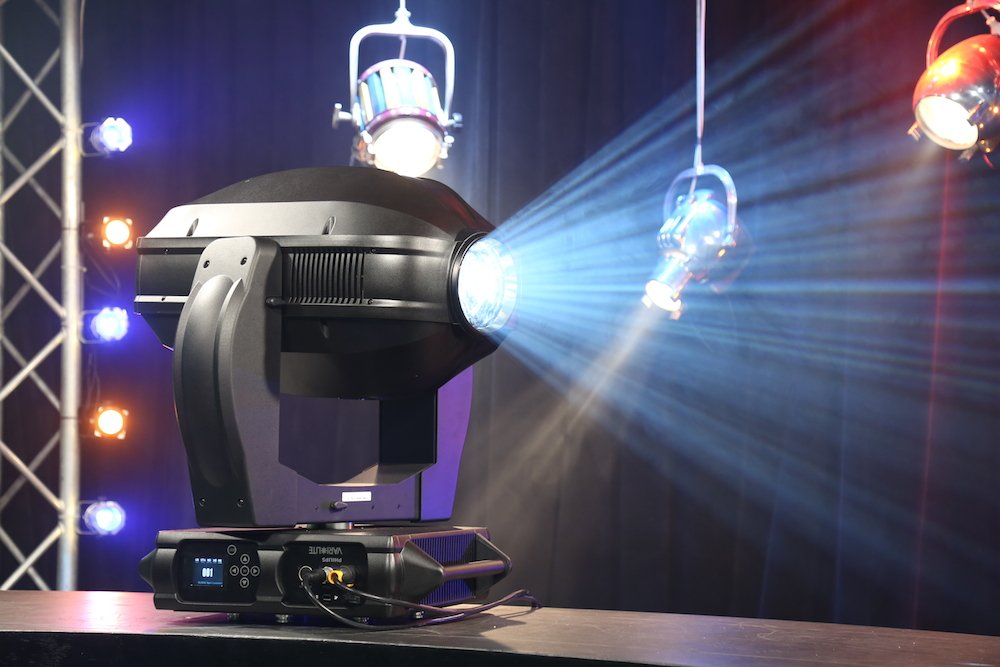News
23 Jul 2015
Review: Vari*Lite VL4000 Spot

Subscribe to CX E-News
Proof that everything’s bigger in Texas
The VL4000 is a mawkish brute of a thing, weighing over 40kg and requiring a minimum of 52 DMX channels to control. The VL4000 uses a 1200W Philips MSR Gold lamp to achieve an output of 33,000 lumens in standard mode. ‘Standard’ mode sees the 1200W lamp run at 1400W, and in the same way that overclocking your computer CPU requires a ridiculous amount of cooling, so too does the lamp. If the fixture itself wasn’t made by the same company who makes the bubble I’d be mildly concerned about this, but I figure since it’s all fundamentally made by Philips they probably know what they’re doing.
If this concept troubles you on some deep and meaningful level, or you just want the fixture to operate a lot more quietly, or even if 25,000 lumens is enough output for your show, then you can run the VL4000 in the more sensible but still very bright ‘Studio’ mode, where the lamp ramps back to 1200W and the fans slow down accordingly.
The VL4000 features a veritable smorgasbord of beam features. There’s literally at least one of everything, and two of most things. CYM colour mixing, two 5+1 colour wheels, 5:1 zoom (allowing 9 to 47 degree beam angle), iris, four blade framing shutters (each shutter can be tilted and the whole framing assembly rotated +/-50 degrees), two gobo wheels each with 7 rotatable indexable slots plus open, two animation wheels with rotatable indexable patterns, three facet rotating prism, frost, and dual blade strobing system. See? Everything. RDM compatibility too. Little wonder it’s so damn big.
You’d imagine that with so much going on inside there would be plenty of opportunity for things to fail, and indeed as much as this is true of any moving light you’d be right. They all combine electricity, heat and mechanics into one place – really the only way to make a moving light any less reliable would be to add water and steam, but that would make it a coffee machine.
Recognising the need for serviceability, Vari*Lite has done a reasonable job of making the various sections of the optical path modular to assist the process. Undo a few tiny connectors and two captive screws, then you can slide out a whole section of the optical path – or at least that’s the theory. I suspect you need to read the manual and follow a procedure when removing modules, since I found each one fouled on its neighbour. I suspect if you know what you’re doing it comes apart very quickly. The side casings of the head itself are plastic and again all the screws are captive so you can’t lose them.
Each side casing has a safety wire which clips to the internal chassis of the head, so it’s safe. All the tiny cables are labeled too, which is another big help.
The full colour backlit LCD screen is easy to navigate, the menu providing all the obvious configuration choices as well as more advanced options. Test mode allows you to check functions individually, which is good since waiting for the entire sequence takes ages simply because there are so many parameters to test! Other noteworthy physical aspects of the fixture include the tilt and pan locks which allow the head to be fixed in place for transit, as well as the PowerCon True1 power connector. The power supply in the VL4000 accepts anything from 200-240V and pulls up to 11A under these conditions. The unit operates happily in any physical orientation.
Re-assembling and firing the unit up, I plugged it into a console and made some scenes. I used the framing shutters quite successfully, and was pleased to observe that the position recall was accurate even after repeated movements of the head and changes to the beam features. Repeatability and accuracy are pretty important for a fixture at this level, and the VL4000 passes on this note. The beam feature buffet is very much an ‘all you can eat’ deal, with reasonable output remaining even after I simultaneously engaged every gobo, colour and other beam function possible. It passed a test it would never encounter in the ‘real world’, which is pretty cool.
I think the VL500 was the best looking moving light that anyone has ever made, and personally I reckon the VL4000 is just ugly by comparison. But that doesn’t matter, because at the end of the day the VL4000 is at its core a very competent and flexible fixture. Its only real limitation is the minimum size show on which you could or would deem it a sensible thing to deploy.
Subscribe
Published monthly since 1991, our famous AV industry magazine is free for download or pay for print. Subscribers also receive CX News, our free weekly email with the latest industry news and jobs.







